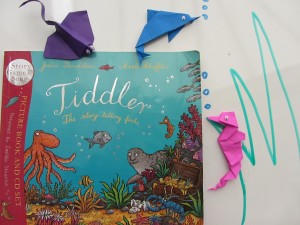by Julia Donaldson
(Ages 3-5)
After five or six iterations, I’d had enough-alo of The Gruffalo, but I
never tire of Julia Donaldson’s lesser-known
hero, a quirky sardine who is caught by fishermen while inventing tall tales to entertain his classmates.
The magic ingredients? A striking, whimsical protagonist, a loyal sidekick (Little Johnny Dory), and a narrative that celebrates the power of imagination, ingenuity, and determination.
I also use Tiddler as a teaching aid, because it’s a textbook illustration of key principles of narrative structure – and why they work. For example:
- The transformational journey and homecoming. Tiddler returns from his adventure as eager to tell stories as ever, but there is a new depth to his account, reflecting his personal growth along the way.
- Character-driven plot, where the protagonist’s idiosyncracies first land him in trouble and then, equip him to prevail — once he learns new skills. Tiddler is caught by the fishermen because he’s daydreaming. As he learns to emerge from his inner world, and read the cues in his environment, he finds his way home by following the Chinese-whispers trail of his stories, which have been passed from fish to fish.
- The rule of three. The story is structured around three episodes. The first two establish the pattern (Tiddler is always late to school, because he’s off dreaming up stories). In the third episode, this pattern is disrupted by the inciting incident (capture by fishermen), which tests the progatonist’s mettle.
I am also impressed by the compact inter-weaving of mutually dependent plot and subplot — each of which achieves a satisfying resolution. Tiddler’s narrative line is complemented by the quest of steadfast Johnny Dory, who champions Tiddler’s stories while others scoff, and brings them home to his granny–thereby starting off the trail of words that ultimately leads Tiddler home. Tiddler succeeds in returning to safety, and Johnny Dory finally succeeds in finding a sympathetic listener, when he describes Tiddler’s adventure “to a writer friend . . . who wrote it down for YOU.”And of course, as a writer, I am enchanted by the stanza–
“I was lost, I was scared, but a story led me home again.”
“Oh no, it didn’t”
“Oh yes, it did!”
I have felt that way so many times.
My one quibble is with the illustrations, that are at times, confusing, and fail to capture the dramatic progression. Tiddler is downright inconspicuous in the illustration of the climactic scene “IN SWAM TIDDLER at half past three!” Surely, the returning hero deserves a spotlight! Furthermore, the margin illustration of the Gruffalo fish on page 20 struck me as shameless product placement worthy of Sex and the City. Julia Donaldson’s text is more sensitively illustrated in the gentle, cyclical Rosie’s Hat, in which Anna Curey’s whimsical pictures intelligently complement the writing to flesh out the narrative and suggest answers to open questions embedded in the text.


No comments yet.